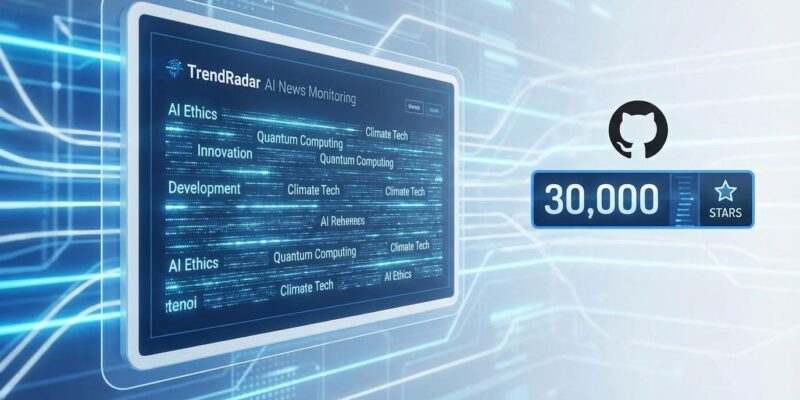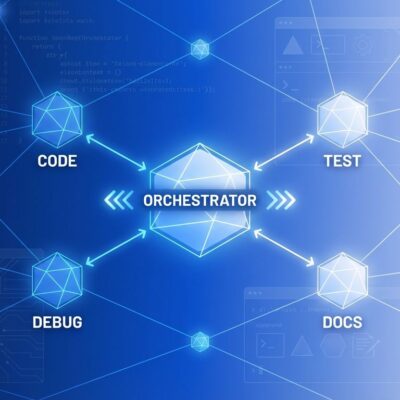
TrendRadar, an open-source AI-powered news aggregation tool, hit 30,000 GitHub stars today with explosive growth of 1,434 stars in the past 24 hours, making it the #1 trending repository on GitHub. Version 3.4.0 launched just two days ago on November 25, adding Slack integration to a platform that monitors 35 news sources across Chinese and international platforms using Model Context Protocol for natural language analysis. The viral spike isn’t random—it proves developers are desperate for better ways to consume technical information beyond passive RSS feeds that can’t filter noise or provide AI-powered insights.
Information Overload Is Real—And RSS Can’t Fix It
The world produces over 403 million terabytes of data each day, with data expected to reach 181 zettabytes by the end of 2025. Microsoft’s 2025 study found individuals receive one notification ping every two minutes, and constant task-switching between digital platforms reduces productivity by up to 40%. Traditional RSS readers like Feedly and Inoreader are passive—they don’t filter noise, provide insights, or aggregate trending topics from social platforms like Hacker News, Reddit, Douyin, or Zhihu.
A 2025 essay about “compression culture” sparked heated debate in the tech community, with professionals pointing out that the industry produces an overwhelming volume of blog posts, research papers, and articles daily. Some software architects have stopped reading tech news entirely after years of chasing every trend. In security operations centers, up to 30% of analyst time is lost chasing false positives due to alert fatigue.
RSS worked brilliantly in the 2000s when fewer sources existed. In 2025, with 35+ platforms to monitor (Twitter/X, HN, Reddit, Discord, Slack, GitHub trending, Douyin, Zhihu, Bilibili), passive RSS feeds create more noise than signal. Algorithm-free isn’t a feature anymore—it’s a weakness.
How TrendRadar Works: MCP-Based AI Analysis Changes Everything
TrendRadar isn’t just another aggregator—it’s an AI-powered intelligent monitoring system built on Model Context Protocol, the open standard introduced by Anthropic in November 2024 and adopted by OpenAI in March 2025. It features 14 AI analysis tools that enable natural language queries like “What are the top AI controversies this week?” or “Sentiment analysis on TypeScript 5 discussions.”
Users configure keyword filters using intuitive syntax (+required, !exclude, @count modifiers), and TrendRadar aggregates trending topics from 35 platforms, applies personalized ranking (60% high-ranking news, 30% persistent topics, 10% ranking quality), and pushes filtered updates to Slack, Telegram, WeChat, or email.
Here’s a sample YAML configuration:
keywords:
- name: "AI News"
words: ["+GPT", "+Claude", "+LLM", "!crypto", "@5"]
channels: [slack, telegram]
- name: "Rust Ecosystem"
words: ["Rust", "cargo", "tokio", "async"]
channels: [email]
push_mode: incremental # Only new content, no duplicates
schedule: "0 9 * * *" # Daily at 9 AMMCP addresses the “N×M integration problem” by providing a universal standard for connecting AI systems with data sources. According to Anthropic: “Since launching MCP in November 2024, the industry has adopted MCP as the de-facto standard for connecting agents to tools and data.” TrendRadar is among the first wave of production MCP tools gaining viral traction, demonstrating the protocol’s real-world value beyond reference implementations.
The shift is fundamental: from passive consumption (“scroll through RSS feed”) to active analysis (“ask AI what’s important”). Developers can query: “Compare sentiment on GitHub Copilot vs Cursor” or “Track how ‘React Server Components’ ranking changed over 30 days” using natural language instead of manually checking platforms. It’s “vibe coding” for news consumption—express intent in plain English, let AI execute.
30-Second Deployment Meets Real Need
TrendRadar’s explosive GitHub growth (1,434 stars in 24 hours) is driven by accessibility: it deploys in 30 seconds via GitHub Pages fork, requires no programming knowledge, and integrates with messaging apps developers already use. The November 25 release of v3.4.0 added Slack integration, making it team-friendly and triggering the viral spike.
Three push modes address different monitoring needs:
- Daily: Comprehensive summaries with all matched news from that day
- Current: Continuous updates with current rankings for fast-moving news
- Incremental (v3.1.0+): Only new content, zero duplication to eliminate notification spam
Users can self-host on GitHub Actions (free tier: 2,000 minutes/month), Docker, or local Python for privacy. Compare this to Feedly Pro ($100+/year for AI features) or building custom monitoring systems (days of development work). Developer tools go viral when they solve real pain points with minimal friction, and TrendRadar nails both.
Chinese Platforms: Feature or Bug?
TrendRadar monitors 35 platforms, but 90% are Chinese: Douyin (TikTok), Zhihu (Chinese Quora), Bilibili, Weibo, Wall Street Journal (Chinese edition), and financial news sources like Cailianshe. This creates a unique competitive advantage—Western developers can’t easily access trending topics from these platforms—but also limits Western adoption since English content is sparse.
The monitored platforms include: Zhihu, Douyin, Bilibili, Wallstreetcn, Tieba, Baidu, Cailianshe, Thepaper, Ifeng, Toutiao, and Weibo. Custom platforms can be added via GitHub contributions, and Western developers have requested Hacker News, Reddit r/programming, and GitHub trending integration in issues.
For developers monitoring Asian tech ecosystems—fintech in China, K-pop tech trends, Chinese AI developments—TrendRadar is invaluable. For Western-only developers, the value is limited unless they supplement with RSS feeds for English sources. The 16,400 forks suggest the community will expand platform coverage. Open source means users can add platforms themselves.
From RSS to AI-Assisted Curation
TrendRadar’s 30,000-star success signals a broader shift in developer information consumption. RSS was revolutionary in the 2000s for escaping email newsletters, but in 2025, RSS is passive and algorithm-free by design—a weakness, not a strength. Developers want AI-powered curation that filters noise, provides sentiment analysis, tracks trend evolution, and answers natural language queries.
Self-hosted solutions like TrendRadar offer control that cloud services can’t match. Information overload isn’t hypothetical—it’s a documented productivity crisis. TrendRadar proves AI-powered self-hosted curation has massive demand. The hybrid approach wins: RSS for publisher content, AI aggregation for trending discussions across platforms. The future isn’t RSS OR algorithms OR AI—it’s intelligent curation with developer control.












